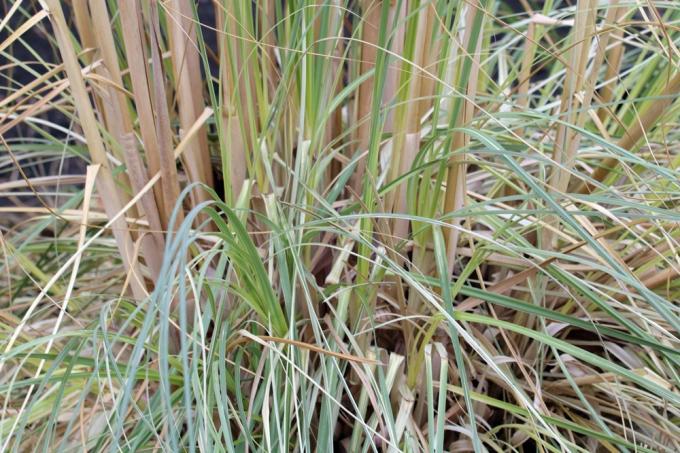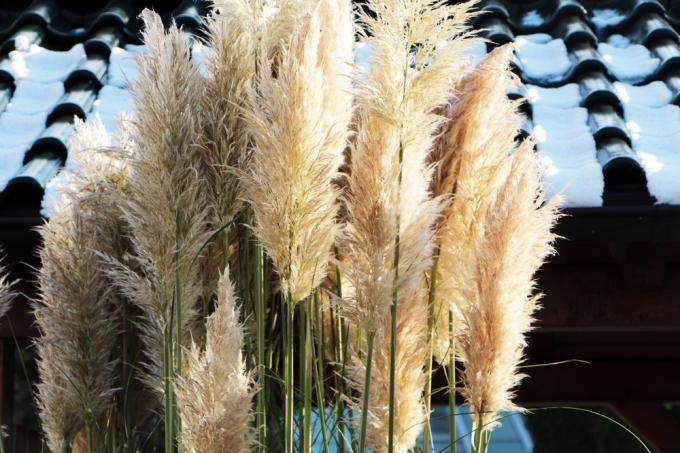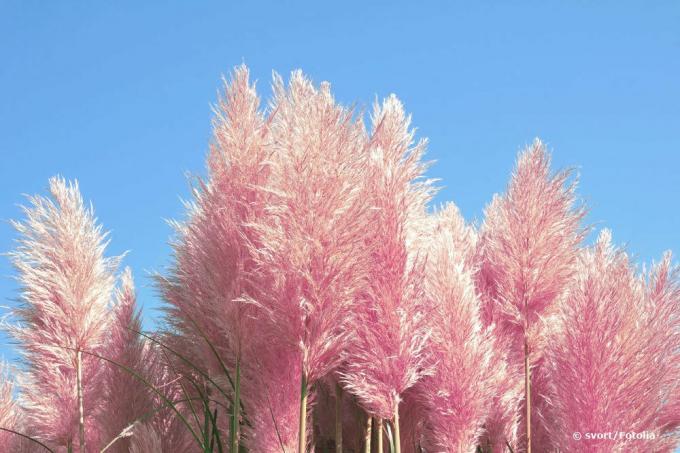
table of contents
- Pampas grass growth
- Growth phase after pruning
- Accelerate growth
- Growth dependent on the variety
- Popular varieties
The American pampas grass (Cortaderia selloana) has its origin in South America. It is very fast growing, easy to care for and only partially winterproof in our latitudes. The imposing sweet grass is increasingly conquering domestic gardens, whether as a solitary plant, in a bucket or as a privacy screen. A special eye-catcher in autumn are the large inflorescences, which are reminiscent of feather duster. During a garden season, the ornamental grass can reach a considerable height, depending on the variety.
Pampas grass growth
Pampas grass adorns many gardens with its frond-shaped flowers. The ornamental grass is considered to be fast growing. Its growth is impressive, but it is still a long time coming. All the facts about pampas grass growth can be found in the article below.
Growth phase after pruning
In spring, when the first new shoots are visible, a must Cut back
of the ornamental grass. Then the new growth phase can begin undisturbed. This then ends in autumn with the formation of the fronds. During the Winter the pampas grass then finally stops growing completely and hibernation begins.Please never cut back the pampas grass in autumn. The leaves serve as winter protection during the cold season. Because if you have now pruned, moisture can enter the stems and freeze. As a result, the heart of the plant begins to rot, and eventually the pampas grass dies.

tip: The leaves of the pampas grass are extremely sharp-edged. Therefore, sturdy gloves must always be worn during maintenance work. In addition, children and pets should also be kept away from the ornamental grass. Because there is a risk of injury.
Accelerate growth
Pampas grass is already considered to be fast-growing. However, there is still a lot that can be done for even better and healthier growth. It doesn't even take that much:
- sunny, sheltered location
- permeable soil
- ideal sandy-stony soil
- no waterlogging
- sufficient supply of nutrients for beautiful stems, inflorescences and lush growth
- fertilize every 14 days from March to September
- Use of compost or special ornamental grass fertilizers from the trade
- correct and regular pruning in spring
- Regular watering during prolonged dry periods
- Winter protection against winter wetness
- cover the root area with a thick layer of leaves or brushwood
- Tie the stalks and fronds together with a soft ribbon
- If necessary, wrap it with jute, no foil
tip: Large clumps can be multiplied by division. To do this, cut off part of the rootstock with a sharp spade and replant.
Growth dependent on the variety
There are over 600 varieties of American pampas grass. However, only a few of them are at home in the gardens in this country. The clump-forming ornamental grass is considered to be fast growing. However, the annual growth varies a lot from variety to variety. A height of 1 m to 3 m can easily be reached. However, the growth in height must be distinguished as follows:
- Stem growth 1 to 1.5 m annually depending on the variety
- Flower fronds (August to November) in one season up to a maximum of 3 m
With the formation of the fronds, the grass has reached its maximum height. However, it should be noted that newly planted perennials in spring need some time to get used to and then begin to grow. It may well be that the maximum height is not reached until the following year.

tip: Due to its rapid growth, pampas grass should always be used as a specimen plant, as it can quickly displace other plants. Sufficient planting distance is then necessary for a combination of varieties.
Popular varieties
25 species of the genus Cortaderia are known worldwide. In addition, there are still many subspecies of American pampas grass and only a few of them are native to this country. There is always a difference in the size and color of the fronds. Here is an overview of the most popular varieties.
Cortaderia selloana "Pumila"
- compact, bushy growing
- Maximum height 150 cm
- white inflorescences in summer, turning brown in autumn
- gray-green foliage
- Flowering September to October
Cortaderia selloana "Compacta"
- Growth height 100 to 120 cm and 40 cm wide
- green leaved
- deciduous
- particularly suitable for rock gardens and pots
- Flower color white to silvery
- Flowering September to October
Cortaderia selloana "Sunningdale Silver"
- Height up to 300 cm
- blue-green foliage
- Silver and white fronds
- Most robust and hardy variety in this country
- Flowering September to October
Cortaderia selloana "Rosea"
- tall up to 250 cm
- arching, spreading growth
- pink fronds
- gray-green foliage
- Flowering September to October

Cortaderia selloana "Evita"
- average height 100 to 150 cm
- yellow fronds
- blue-green foliage
- Flowering from August to October
Cortaderia selloana "Patagonia"
- medium size up to 150 cm
- light to reddish flower color
- light green foliage
- Flowering from September to November
Cortaderia selloana "Aureolineata"
- Growth height up to 250 cm and up to 150 cm wide
- upright stems
- white-silvery fronds
- yellow-striped foliage
- Flowering September to October
Cortaderia selloana "Citaro"
- Height up to 250 cm and up to 120 cm in width
- yellow-white fronds
- green foliage
- Flowering August to November
Cortaderia selloana "Silver Comet"
- Growth height 100 to 150 cm and also in width
- creamy yellow fronds
- white-leaved
- Flowering from September to November

tip: Only female plants should be planted for a beautiful look. Male fronds become quite unsightly after dusting the pollen.
